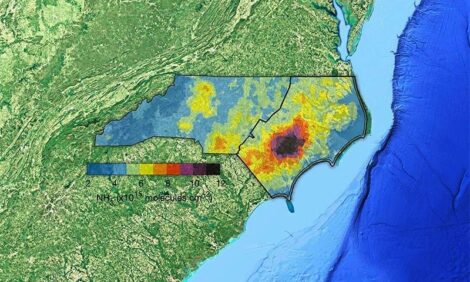



US Pork Outlook Report - February 2007
By U.S.D.A., Economic Research Service - This article is an extract from the February 2007: Livestock, Dairy and Poultry Outlook Report, highlighting Global Pork Industry data.
Pork Demand Jumps in January
USDA increased its estimate for first-quarter 2007 hog prices to $44-$46 per cwt, largely due to strong demand conditions. The live equivalent price of 51-52 percent lean hogs averaged $44.04 in January, 6.5 percent higher than the same period last year.
Stronger pork demand than a year ago is suggested by the USDA Estimated Pork Carcass Cutout for January, which at $63.67 per cwt was more than 4 percent above last January. The Estimated Pork Carcass Cutout is an estimate of the value of the hog carcass based on current prices being paid for pork cuts, by wholesalers representing their foreign and domestic (i.e. hotel, restaurant, and institution (HRI), and retail) customers.
Stronger year-over-year pork demand in January likely had both foreign and domestic components. While export demand was almost certainly an important contributor to higher pork prices, given the very strong performance of U.S. pork on international markets in 2006, domestic consumption typically accounts for about 85 percent of U.S. pork production. It is likely that higher prices for pork in January are a result of increased domestic demand for pork products, brought about by a generally strong U.S. economic picture—strong GDP growth, relatively low unemployment rates, somewhat lower gasoline prices—and also, to some degree, to higher prices of substitute goods, in this case, popular broiler cuts.
For the first quarter of 2007, pork production is expected to be nearly 5.4 billion pounds, or 1 percent above first quarter last year. For 2007, 3 percent more production is expected—21.65 billion pounds—with hog prices likely to range between $44 and $46 per cwt. Prices averaged $47.26 per cwt last year.


U.S Exports End 2006 on a High Note
U.S. pork exporters capped off an exceptional year by shipping 279 million pounds in December, more than 15 percent above December 2005. For the calendar year, U.S. pork exports were just shy of 3 billion pounds—2.997 billion pounds—more than 12 percent higher than in 2005.
The dynamics of U.S pork exports were different in 2006 than in previous years. Before 2006, the “kick” behind foreign demand for U.S. pork came primarily from the combination of Japan, Mexico, and Canada. While these three countries remain crucial to the well-being of the U.S. pork sector, the real story in 2006 was the huge increase in demand from Russia and South Korea. Exports to Russia increased 123 percent in 2006; shipments to South Korea were 54 percent larger in 2006 than in 2005.
Figures in the table below show how market shares shifted last year to reflect large shipments to Russia and South Korea. Russia’s share of U.S. exports doubled, from almost 4 percent in 2005 to 7 percent last year. South Korea’s share increased from about 7 percent to 10 percent. Japan’s share of U.S. exports, on the other hand, dropped from 39 percent to 34 percent. Export shares of Canada and Mexico last year, stayed about the same as in 2005.
In 2007, U.S. exporters are expected to ship almost 3.2 billion pounds of pork to foreign destinations. Exports to Russia and South Korea are expected to be very important again in 2007. The dramatic increases in Russian and South Korean demand for U.S. pork resulted from disease incidents: Foot and mouth disease in Brazil caused Russia to ban pork from affected Brazilian states, and South Korea banned U.S. beef imports after BSE incidents occurred in the United States. As these disease issues are resolved and trade re-established, it is likely that, at least to some degree, U.S. pork will be affected.

U.S. Pork Imports Lower in 2006
U.S. pork imports were 990 million pounds in 2006, more than 3 percent lower than in 2005. The low exchange value of the U.S. dollar last year was likely the major reason for lower U.S. imports. Of the two largest suppliers of pork to the United States--Canada and Denmark—Canada shipped about 5 percent less pork to the United States last year, while Denmark’s imports increased by more than 3 percent compared with 2005.
Imports from Denmark showed a year-over-year increase, likely, in part, because U.S. pork imports have become specialized to particular cuts, and U.S. demand for each cut responds differently to price changes. An important component of U.S. imports from Denmark is back ribs, available from Danish hogs that tend to be smaller than U.S. hogs. The specialized nature of the back ribs limits the possibility of substitution when prices increase.
Canada’s share of U.S. pork imports has increased over the past 10 years, while Denmark’s share has declined. In 1997, Canada accounted for about 70 percent of U.S. imports, while last year 80 percent of U.S. imports came from Canada. Denmark’s share declined from 20 percent in 1997 to 10 percent last year. Canada dominates U.S. import markets due largely to proximity: transport costs are obviously lower compared with products from Denmark. Further, various trade agreements, as well as technical and management innovations have played significant roles in lowering the costs of transactions between “neighbors.”
Imports of Canadian Swine Increase in 2006, and Likely in 2007
U.S. hog finishers and processors imported 8.763 million head of swine last year, an increase of almost 7 percent over imports in 2005. All U.S imports of live swine last year were of Canadian origin. U.S. swine imports in 2006 were comprised mainly of animals for finishing (69 percent) and slaughter hogs (30 percent). The larger numbers in 2006 were a consequence of strong demand in the United States and soft packer demand in Canada, rather than production increases in Canada. In fact, Federal slaughter last year was 2.4 percent lower than in 2005. Further, through December Canadian breeding herd numbers were 1 percent lower than a year earlier, and the pig crop was more than 1 percent lower than in the same period of 2005.
Disease problems and the strong Canadian currency plagued the Canadian pork industry last year. The strong Canadian dollar continues to impose a serious drag on Canadian pork products in international markets, particularly those in which Canada competes directly with U.S. pork products. The competitiveness problems created by the strong Canadian dollar have weakened the processing industry in Canada; Canada’s largest packers are contracting planned and existing slaughter capacity.
USDA’s expectations of more than 3 percent larger swine imports from Canada in 2007 are based on continuing of exchange rate trends and turbulence in the Canadian processing industry, rather than on production increases. Among the key swine import determinants in 2007 will be the pace and disposition slaughter capacity of Canada’s two largest pork processors, Maple Leaf Foods, and Olymel.
Further Information
For more information view the full Livestock, Dairy and Poultry Outlook - February 2007 (pdf)February 2007







